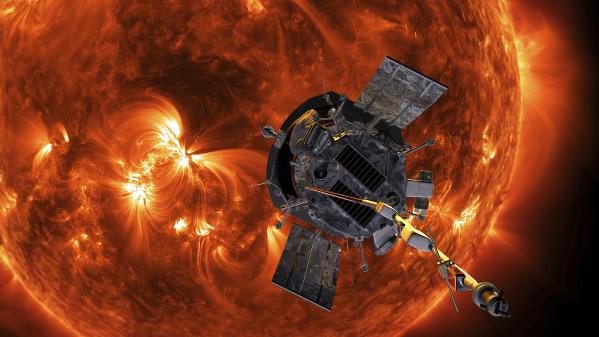NASA craft prepares for journey to the sun
A red-hot voyage to the sun is about to bring us closer to the star than ever before.
NASA's Parker Solar Probe will hurtle through the sizzling solar atmosphere and come within just 3.8 million miles of the surface.
This spacecraft is about to make history as it embarks on a mission that will bring us closer to the sun than ever before.

This image made available by NASA shows an artist's rendering of the Parker Solar Probe approaching the Sun. It's designed to take solar punishment like never before, thanks to its revolutionary heat shield that’s capable of withstanding 2,500 degrees Fahrenheit (1,370 degrees Celsius). [Photo: AP]
NASA's Parker Solar Probe will fly within 4 million miles of the sun.
While that still sounds like a long way away - it's all a matter of perspective.
"If you think about the Earth and the sun being on a metre stick we're actually getting within four centimetres of the sun on that edge," says Betsy Congdon, lead engineer for Parker Solar Probe's heat shield.
Scientists hope the 1.5 billion US dollar mission will help them unravel some of the sun's mysteries.
One of their goals is to learn why the sun's atmosphere is so much hotter than its surface.
"We're used to the idea that if I'm standing next to a campfire, and I walk away from it, it gets cooler. But this is not what happens on the sun," explains Alex Young, solar scientist at NASA Goddard Space Flight Centre.
"As we go from the surface of the sun, which is ten thousand degrees, and quickly move up into the corona, we find ourselves quickly at millions of degrees. So this is a fundamental question that drives not only how this star works, our sun, but actually all the stars in the universe."
Scientists say they're also trying to understand what drives solar wind and storms so that they can predict them in advance.
"This space weather has direct influence, not always positive, on our technology in space, our spacecraft, can disrupt our communications and creates a hazardous environment for astronauts and in the most extreme cases of these space weather events it can actually affect our power grids here on the Earth," says Young.
"So, it's of fundamental importance for us to be able to predict this space weather much like we predict weather here on Earth, terrestrial weather."
The technology for surviving close solar encounter hasn't been available until now.
The spacecraft is protected by a heat shield capable of withstanding 2,500 degrees Fahrenheit, or 1,370 degrees Celsius. It was developed by researchers at the John Hopkins University Applied Physics Laboratory.
As it approaches the sun, it will hit speeds of up to 430,000 miles per hour. That's like going from Chicago to Beijing in under a minute.
Roughly the size of a small car, Parker will get nearly seven times closer to the sun than previous spacecraft.
"The public should be excited not only for the historic aspect of this thing but because the technological achievement that humanity has made. I mean, this is just an incredible technology advancement," says Andy Driesman, project manager for Parker Solar Probe.
The Parker probe will fly past Venus seven times over seven years to get close to the sun.
Each flyby will provide an orbit-shaping gravity boost, drawing it ever closer to the sun and straight into the corona - the sun's outermost atmosphere.
It will reach its closest approach to the sun on the final three orbits in 2024 and 2025.
The Parker Solar Probe is planned to launch from Space Launch Complex 37 on Cape Canaveral Air Force Station in Florida on Saturday 11 August 2018.
Your Comment
Name E-mailRelated News
-
-

-
In pics: closing ceremony of 2018 FIFA World Cup
Photos taken showing the closing ceremony of 2018 FIFA World Cup.
-
-
-
Thai officials approve compensation for Phuket boat capsizing
Thailand authorities are preparing a compensation package worth 63.9 million Thai Baht (around 1.93 million USD) to the victims of the Phuket boat accident, reports Thailand's World Journal.







